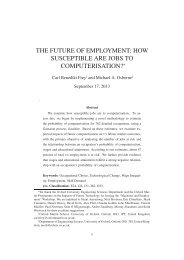THE FUTURE OF EMPLOYMENT: HOW SUSCEPTIBLE ARE JOBS TO COMPUTERIZATION?
We examine how susceptible jobs are to computerization. To assess this, we begin by implementing a novel methodology to estimate the probability of computerization for 702 detailed occupations, using a Gaussian process classifier. Based on these estimates, we examine expected impacts of future computerization on US labor market outcomes, with the primary objective of analyzing the number of jobs at risk and the relationship between an occupation’s probability of computerization, wages and educational attainment. According to our estimates, about 47 percent of total US employment is at risk. We further provide evidence that wages and educational attainment exhibit a strong negative relationship with an occupation’s probability of computerization.
We examine how susceptible jobs are to computerization. To assess this, we begin by implementing a novel methodology to estimate the probability of computerization for 702 detailed occupations, using a Gaussian process classifier. Based on these estimates, we examine expected impacts of future computerization on US labor market outcomes, with the primary objective of analyzing the number of jobs at risk and the relationship between an occupation’s probability of computerization, wages and educational attainment. According to our estimates, about 47 percent of total US employment is at risk. We further provide evidence that wages and educational attainment exhibit a strong negative relationship with an occupation’s probability of computerization.
Create successful ePaper yourself
Turn your PDF publications into a flip-book with our unique Google optimized e-Paper software.
set the boundaries for economic development, but rather powerful social and<br />
economic interests promoting the technological status quo. This is nicely illustrated<br />
by the example of William Lee, inventing the stocking frame knitting<br />
machine in 1589, hoping that it would relieve workers of hand-knitting. Seeking<br />
patent protection for his invention, he travelled to London where he had<br />
rented a building for his machine to be viewed by Queen Elizabeth I. To his<br />
disappointment, the Queen was more concerned with the employment impact<br />
of his invention and refused to grant him a patent, claiming that: “Thou aimest<br />
high, Master Lee. Consider thou what the invention could do to my poor subjects.<br />
It would assuredly bring to them ruin by depriving them of employment,<br />
thus making them beggars” (cited in Acemoglu and Robinson, 2012, p. 182f).<br />
Most likely the Queen’s concern was a manifestation of the hosiers’ guilds fear<br />
that the invention would make the skills of its artisan members obsolete. 5 The<br />
guilds’ opposition was indeed so intense that William Lee had to leave Britain.<br />
That guilds systematically tried to weaken market forces as aggregators to<br />
maintain the technological status quo is persuasively argued by Kellenbenz<br />
(1974, p. 243), stating that “guilds defended the interests of their members<br />
against outsiders, and these included the inventors who, with their new equipment<br />
and techniques, threatened to disturb their members’ economic status.” 6<br />
As pointed out by Mokyr (1998, p. 11): “Unless all individuals accept the<br />
“verdict” of the market outcome, the decision whether to adopt an innovation<br />
is likely to be resisted by losers through non-market mechanism and political<br />
activism.” Workers can thus be expected to resist new technologies, insofar that<br />
they make their skills obsolete and irreversibly reduce their expected earnings.<br />
The balance between job conservation and technological progress therefore, to<br />
a large extent, reflects the balance of power in society, and how gains from<br />
technological progress are being distributed.<br />
The British Industrial Revolution illustrates this point vividly. While still<br />
widely present on the Continent, the craft guild in Britain had, by the time of<br />
5 The term artisan refers to a craftsman who engages in the entire production process of a<br />
good, containing almost no division of labour. By guild we mean an association of artisans that<br />
control the practice of their craft in a particular town.<br />
6 There is an ongoing debate about the technological role of the guilds. Epstein (1998), for<br />
example, has argued that they fulfilled an important role in the intergenerational transmission of<br />
knowledge. Yet there is no immediate contradiction between such a role and their conservative<br />
stand on technological progress: there are clear examples of guilds restraining the diffusion of<br />
inventions (see, for example, Ogilvie, 2004).<br />
6





